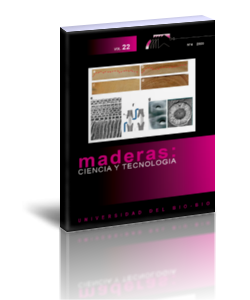Estimation model of mechanical properties from the compressive strength values
Keywords:
Brazilian hardwood species, compressive strength, regression models, shear strength, tensile strengthAbstract
To ensure the safety of wooden structures, estimation of wood strength is based on the characteristic
strength values. The Brazilian standard (NBR, in Portuguese Norma Brasileira Regulamentadora) 7190 proposes
equations to estimate the strength properties with a simplified procedure, which allows obtaining the
characteristic values through relations that correlate different mechanical properties. Using these equations,
the values of tensile (ft0,k) and shear (fv0,k) strength can be calculated in a simplified way from the compressive
strength (fc0,k) values. In the present work, 36 tropical hardwood species were evaluated for tensile, shear and
compressive strength in the direction parallel to the grain, with a total of 1296 experimental measurements,
and the precision of the relations defined by the Brazilian standard was assessed using the analysis of variance
(ANOVA) method. Two-parameter regression models, based on linear, exponential, logarithmic and geometric
functions, were used as an alternative proposal for the estimation of the strength properties. The statistical
analysis validated the proposed relations, with the linear (ft0,k) and geometric (fv0,k) regression models being
the models of best fit, with the coefficients of determination (R2) equal to 63,02 % and 70,15 %, respectively.
In addition, new simplified equations were suggested. The least squares method was used to determine the
optimal coefficient (α) for validation of the Brazilian standard equations. The obtained coefficients validated
the tensile strength relationship (ft0,k = fc0,k / 0,77), but failed to validate the shear strength relationship (fv0,k =
0,12∙ fc0,k). In the latter case, the obtained values were significantly higher (up to 91 % higher) when compared
to those estimated by the Standard
Downloads
References
Christoforo, A.L.; Almeida, A.S.; Lanini, T.L.S.; Nogueira, R.S.; Lahr, F.A.R. 2019a. Estimation of the characteristic value of wood strength. Eng Agr-Jaboticabal 39(1): 127–132. https://doi.org/10.1590/1809-4430-eng.agric.v39n1p127-132/2019.
Christoforo, A.L.; Aquino, V.B.M.; Wolenski, A.R.V.; Araujo, V.A.; Lahr, F.A.R. 2019b. Evaluation of the Peltophorum vogelianum Benth. Wood Species for Structural Use. Eng Agr-Jaboticabal 39(6): 763–768. https://doi.org/10.1590/1809-4430-eng.agric.v39n6p763-768/2019.
Dadzie, P.K.; Amoah, M. 2015. Density, some anatomical properties and natural durability of stem and branch wood of two tropical hardwood species for ground applications. Eur J Wood Wood Prod 73(6): 759-773. https://doi.org/10.1007/s00107-015-0925-x.
Fernandes, N.C.L.; Valle, M.L.A.; Calderon, C.M.A. 2018. Physical and anatomical characteristics of Cedrela odorata L. and Cedrelinga cateniformis Ducke. Floresta e Ambiente 25(1): 1-10. https://doi.org/10.1590/2179-8087.100814.
Icimoto, F.H.; Ferro, F.S.; Almeida, D.H.; Christoforo, A.L.; Lahr, F.A.R. 2015. Influence of specimen orientation on determination of elasticity in static bending. Maderas-Cienc Tecnol 17(2): 229-238. http://dx.doi.org/10.4067/S0718-221X2015005000022.
ISO. 2005. Structural timber – characteristic values of strength-graded timber – sampling, full-size testing and evaluation. ISO 13910. 2005. 30 p. Geneva, Switzerland.
Logsdon, N.B.; De Jesus, J.H.; Penna, J.E. 2010. Evaluation of the estimators of the characteristic strength to compression parallel to the grain. Sci For 38(88): 579-587. https://www.ipef.br/publicacoes/scientia/nr88/cap04.pdf.
Longui, E.L.; Pires, G.T.; Ballarin, A.W.; Machado, J.A.R. 2017. Shear strength parallel to grain with distinct ray orientation on four Brazilian wood species. Eur J Wood Wood Prod 75(4): 663-665. https://doi.org/10.1007/s00107-016-1129-8.
Matos, G.S.; Molina, J.C. 2016. Shear strength of wood in direction parallel to the grain according to the standards ABNT NBR 7190:1997 and ISO 13910:2005. Materia 21(4): 1069-1079. https://doi.org/10.1590/s1517-707620160004.0098.
NBR. 1997. Projeto de estruturas de madeira. NBR 7190. 1997. 107 p., Rio de Janeiro, Brazil.
Ruelle, J.; Beauchêne, J.; Yamamoto, H.; Thibaut, B. 2011. Variations in physical and mechanical properties between tension and opposite wood from three tropical rainforest species. Wood Sci Technol 45(2): 339-357. https://doi.org/10.1007/s00226-010-0323-9.
Segundinho, P.G.A.; Lahr, F.A.R.; Regazzi, A.J.; Carreira, M.R. 2015. Variation of modulus of elasticity obtained through the static bending method considering the S/h ratio. Wood Res-Slovakia 60(2): 189-200. http://www.woodresearch.sk/wr/201502/02.pdf.
Silva, C.E.G.; Almeida, D.H.; Almeida, T.H.; Chahud, E.; Branco, L.A.M.N.; Campos, C.I.; Lahr, F.A.R, Christoforo, A.L. 2018. Influence of the procurement site on physical and mechanical properties of Cupiúba wood species. BioResources 13(2): 4118-4131. https://doi.org/10.15376/biores.13.2.4118-4131.
Silva, F.; Higuchi, N.; Matos, J.M.; Paula, E.M.; Santos, J. 2014. Nondestructive evaluation of hardness in tropical wood. J Trop For Sci 26(1): 69-74. https://www.jstor.org/stable/23617015.
Soriano, J.; Veiga, N.S.; Martins, I.Z. 2015. Wood density estimation using the sclerometric method. Eur J Wood Wood Prod 73(1): 753-758. https://doi.org/10.1007/s00107-015-0948-3.
Steege, H.; Vaessen, R.W.; Cárdenas-López, D.; Sabatier, D.; Antonelli, A.; Oliveira, S.M.; Pitman, N.C.A.; Jørgensen, P.M.; Salomão, R.P. 2016. The discovery of the Amazonian tree flora with an update checklist of all known tree taxa. Scientific Reports 6. https://doi.org/10.1038/srep29549.
Tenorio, C.; Moya, R. 2018. Evaluation of wood properties of four ages of Cedrela odorata trees growing in agroforestry systems with Theobroma cacao in Costa Rica. Agroforest Syst 93: 973-988. https://doi.org/10.1007/s10457-018-0194-x
Weerahandi, S. 1995. ANOVA under unequal error variances. Biometrics 51(2): 589-599. https://www.jstor.org/stable/2532947.

































